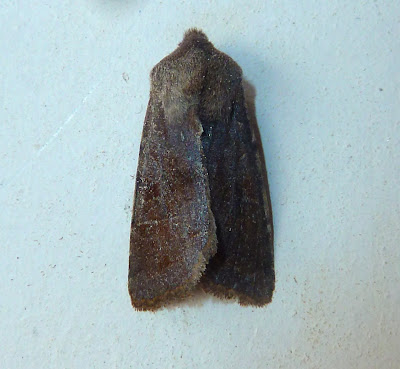.....As well as the ongoing survey of the wood, myself and Trent Duval were also testing a new light source for use with a battery. We put the traps 10 metres apart in a location that we've used many times before and simply compared the catch. The trouble is, from early on it was clear that the original Actinic/UV was performing much better than the low voltage 4.8w white LED lights on the other trap. By the next day the extent of the difference was very clear despite the LED appearing(to our eyes at least!) to be far brighter than the actinic.
Original battery 30w actinic/UV
The whole reason for the experiment was to devise an extremely light alternative to lugging the heavy car battery into the wood. The fold down sides and control box already fit into a rucksack, so the battery is the stumbling block. Here is the list for the original-
36 moths of 11 species-
0663 Diurnea fagella 4
1746 Shoulder Stripe (Anticlea badiata) 1
1927 Brindled Beauty (Lycia hirtaria) 3 NFS
1930 Oak Beauty (Biston strataria) 5
1947 Engrailed (Ectropis bistortata) 2
2182 Small Quaker (Orthosia cruda) 9
2187 Common Quaker (Orthosia cerasi) 3
2188 Clouded Drab (Orthosia incerta) 1
2190 Hebrew Character (Orthosia gothica) 2
2258 Chestnut (Conistra vaccinii) 5
+ 1 micro to identify
4.8w white LED version
Alas, as can be seen by the low catch. Moths clearly don't really like the LED lights. So back to the drawing board as I don't think there is an actinic LED solution out there? If filters or a coating for the lights could be used- could it be made to work? A shame really, because weight and size wise, it's perfect. Strangely though, it was preferred by one species; Streamers seemed to like it! More info HERE
Just 5 moths of 4 species-
2182 Small Quaker (Orthosia cruda) 1
2190 Hebrew Character (Orthosia gothica) 1
+ 1 acleris sp. to be identified

























